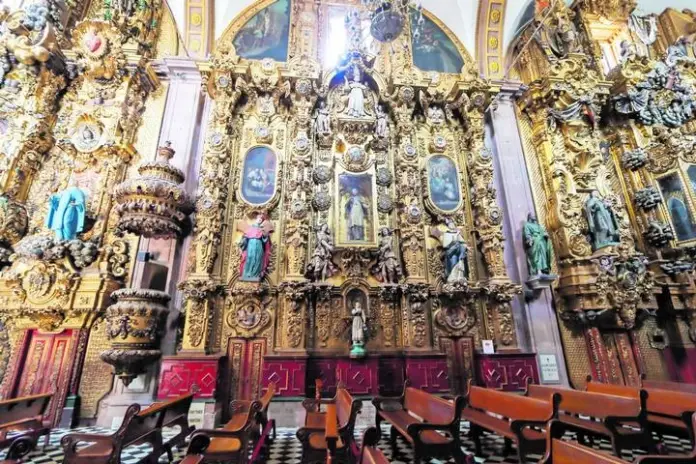.jpg)
The city preserves deep-rooted religious syncretism and is an important destination for sacred art with imposing churches and convents in its 18 municipalities.
And among the main attractions in the Queretaro capital are the exquisite altarpieces of the temples of Santa Rosa de Viterbo and Santa Clara, two baroque buildings of great value.
Santa Rosa de Viterbo
Located on Arteaga Street # 89 in the Historic Center of Queretaro, Santa Rosa de Viterbo is a marvel for its building, which is the only one in Mexico dedicated to this saint, originally from the city of Viterbo in Italy.
The sacred design of the 18th century baroque is surprising, whose walls, according to experts, hold more than two centuries of history and among all this treasure are five imposing altarpieces, bathed in gold leaf; the pulpit displays rich ornamentation with inlays of precious woods, ivory, silver and tortoiseshell.
In the lower choir there is the eclectic altarpiece, the 18th century organ and the chapel of the Blessed Sacrament, divided from the nave by a panel with fifteen medallions and a sculpture of Jesus Christ on the cross.
In turn, the upper choir is divided by a golden fan with the image of Jesus as a teenager. In this part there is also a Walcker organ from the beginning of the century.
The temple of Santa Rosa de Viterbo was built by Francisco Martínez Gudiño, an architect from Querétaro, and Ignacio Mariano de las Casas, the latter still retains his signature in the lower choir of the enclosure.
Going into detail in the temple you can admire the paintings of Captain Velázquez de Lorea by Miguel Cabrera and the portrait of Sister Ana María de San Francisco y Neve, a work attributed to the master José Páez, considered one of the most beautiful paintings made of a nun and who, according to Querétaro legends, still tends to appear in the place.
Altarpieces of Santa Clara
The temple of Santa Clara, like that of Santa Rosa de Viterbo, has baroque art from the end of the 17th century, one of the most significant in its style for Latin America. In this convent building located on the Andador de Madero corner with Allende, it currently has six altarpieces, four of them on the gospel side and the other two on the epistle side.
The upper ground floor has a side altarpiece and an almost intact altarpiece in the anastil style, with two bodies. It also has four pillars, a niche that still preserves its sculptures as well as the central lantern where the paintings of the Immaculate Conception are found, with Saint Anne on one side; on the right side Saint Joachim and on the left side Saint John the Evangelist and other saints, above the lantern you can see the Holy Trinity.
One of the peculiarities of this temple, which in those years was also the convent of the Clarisse nuns and was founded in the 17th century by Don Diego de Tapia, son of Fernando de Tapia “Conin”, did this to please his daughter María Luisa and ensure her religious destiny.
Today only the temple and a very small part of what was the convent remain, but much of the history that marked not only the city, but also the country was written here and during the viceroyalty it was one of the largest and most important convents of New Spain, however it was destroyed during the Reform War.
The place temporarily served as a prison for the heroine Doña Josefa Ortiz de Domínguez, during the war of independence. What would the Corregidora think during her stay there?
In addition, you can find in the Temple of Santa Clara a museum-gallery, located on Allende street number 1, where there is an interesting exhibition of articles such as photographs and books about the history of the place.
Don’t miss out on these religious destinations on your next visit, where you will discover great works and monuments that have a lot of history to tell. Querétaro awaits you with open arms!
Source: elsoldemexico






